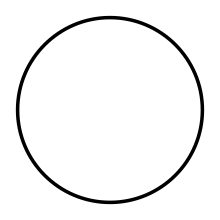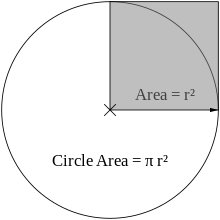Draw a Circle of Radisu R Centered at the Origin

A circumvolve is a round, two-dimensional shape. All points on the edge of the circle are at the same distance from the center.
The radius of a circle is a line from the heart of the circumvolve to a betoken on the side. Mathematicians use the letter of the alphabet for the length of a circumvolve's radius. The heart of a circle is the bespeak in the very middle. It is oftentimes written as :).
The diameter (meaning "all the way across") of a circumvolve is a straight line that goes from 1 side to the reverse and right through the center of the circle. Mathematicians use the letter for the length of this line. The diameter of a circle is equal to twice its radius ( equals 2 times ):[1]
The circumference (significant "all the way around") of a circle is the line that goes around the center of the circumvolve. Mathematicians use the letter of the alphabet for the length of this line.[two]
The number π (written equally the Greek letter of the alphabet pi) is a very useful number. It is the length of the circumference divided by the length of the diameter ( equals divided by ). Equally a fraction the number is equal to about or (which is closer) and as a number it is about 3.1415926535.

The expanse of the circumvolve is equal to times the area of the grayness foursquare.
The surface area, , inside a circle is equal to the radius multiplied by itself, and then multiplied by ( equals times times ).
Calculating π [change | modify source]
can be measured past drawing a circle, then measuring its diameter ( ) and circumference ( ). This is because the circumference of a circumvolve is always equal to times its bore.[1]
tin can too be calculated by only using mathematical methods. Most methods used for calculating the value of take desirable mathematical properties. However, they are hard to sympathise without knowing trigonometry and calculus. However, some methods are quite simple, such as this form of the Gregory-Leibniz series:
While that series is easy to write and calculate, it is not easy to see why it equals . A much easier way to approach is to describe an imaginary circumvolve of radius centered at the origin. Then any bespeak ( , ) whose distance from the origin is less than , calculated by the Pythagorean theorem, volition be within the circle:
Finding a set of points inside the circle allows the circle'south area to be estimated, for case, by using integer coordinates for a big . Since the expanse of a circumvolve is times the radius squared, tin be approximated by using the following formula:
Calculating the surface area, circumference, diameter and radius of a circle [change | modify source]
Area [change | change source]
Using its radius:
Using its diameter:
Using its circumference:
Circumference [change | alter source]
Using its diameter:
Using its radius:
Using its area:
Bore [alter | change source]
Using its radius:
Using its circumference:
Using its area:
Radius [alter | change source]
Using its diameter:
Using its circumference:
Using its area:
[modify | change source]
- Semicircle
- Sphere
- Squaring the circle
- Pi
- Pi (letter)
- Tau
References [change | modify source]
- ↑ i.0 1.ane Weisstein, Eric W. "Circumvolve". mathworld.wolfram.com . Retrieved 2020-09-24 .
- ↑ "Basic information about circles (Geometry, Circles)". Mathplanet . Retrieved 2020-09-24 .
Other websites [change | alter source]
| | Wikimedia Commons has media related to Circumvolve . |
- Calculate the measures of a circle online Archived 2007-09-28 at the Wayback Machine
Source: https://simple.wikipedia.org/wiki/Circle

























0 Response to "Draw a Circle of Radisu R Centered at the Origin"
Publicar un comentario